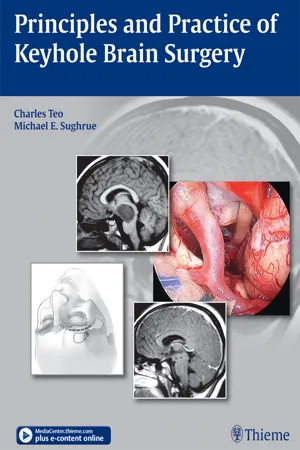
- 272 pages
- English
- PDF
- Available on iOS & Android
Principles and Practice of Keyhole Brain Surgery
About this book
A step-by-step guide to modern techniques of keyhole brain surgery
Developed 20 years ago by leading innovators in the field, the keyhole concept of brain surgery has become an integral part of the practice of neurosurgery. This timely and comprehensive book covers the thinking, philosophy, and techniques of modern keyhole brain surgery, including a realistic assessment of its benefits and limitations. Written by expert practitioners and highlighted by vivid surgical illustrations and procedural videos, Principles and Practice of Keyhole Brain Surgery functions as an experienced mentor working side by side with neurosurgeons as they master the techniques.
Special Features:
- Introduces the basic principles of the keyhole approach, including the practical, technical, and logistical aspects of planning procedures and operating through small openings
- Beautifully illustrated with nearly 900 endoscopic images, diagrams, surgical drawings, and operative photographs, many showing step-by-step procedures
- Details the pivotal role of the endoscope in keyhole brain surgery and its ability to provide multiple angles of visualization, including a useful catalog of clinical situations where the endoscope has proven most effective
- Demonstrates contemporary keyhole approaches (e.g. the eyebrow/sub-frontal approach) in procedures for supratentorial intra-axial brain tumors, tumors of the cribriform plate and orbit, parasellar masses, craniopharyngiomas, tumors of the middle fossa and cavernous sinus and many other conditions in the cranial base
- Offers more than 100 procedural videos on the Thieme's MediaCenter, narrated by the authors and aligned to chapters in the book for an unparalleled learning resource
Providing all the information necessary to achieve surgical goals through well placed, smaller openings—with the added benefits of shorter procedures, fewer wound complications and better patient outcomes— Principles and Practice of Keyhole Brain Surgery is essential for every neurosurgeon in practice today.
Frequently asked questions
- Essential is ideal for learners and professionals who enjoy exploring a wide range of subjects. Access the Essential Library with 800,000+ trusted titles and best-sellers across business, personal growth, and the humanities. Includes unlimited reading time and Standard Read Aloud voice.
- Complete: Perfect for advanced learners and researchers needing full, unrestricted access. Unlock 1.4M+ books across hundreds of subjects, including academic and specialized titles. The Complete Plan also includes advanced features like Premium Read Aloud and Research Assistant.
Please note we cannot support devices running on iOS 13 and Android 7 or earlier. Learn more about using the app.
Information
Table of contents
- Principles and Practice of Keyhole Brain Surgery
- Media Center Information
- Title Page
- Copyright
- Dedication
- Contents
- Video Contents
- Foreword
- Preface
- Acknowledgments
- Contributors
- Abbreviations
- 1 An Introduction to the Keyhole Concept
- 2 Cognitive Principles of Planning Keyhole Approaches
- 3 Technical Principles of Operating in Keyhole Craniotomies
- 4 The Role of Endoscopy in Keyhole Surgery
- 5 An Atlas of Intracranial Endoscopy
- 6 Steps in Common Keyhole Approaches
- 7 Endonasal Surgery and Its Current Role in Neurosurgical Paradigms
- 8 Keyhole Surgery for Supratentorial Intra-Axial Tumors
- 9 Keyhole Approaches to Tumors of the Cribriform Plate and Orbit
- 10 Keyhole Approaches to Parasellar Masses and the Interpeduncular Space
- 11 Craniopharyngiomas
- 12 Keyhole Approaches to Tumors of the Middle Fossa, Cavernous Sinus, Tentorium and Lateral Midbrain
- 13 The Cerebellopontine Angle
- 14 Tackling the Petrous Apex through a Keyhole
- 15 Keyhole Surgery of the Tectum and Pineal Region
- 16 Keyhole Surgery for Foramen Magnum, Fourth Ventricular, and Midline Cerebellar Tumors
- Index